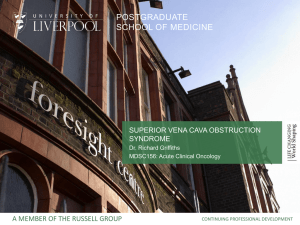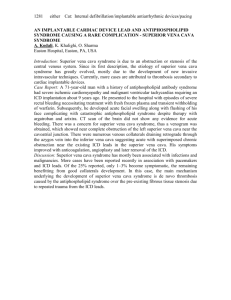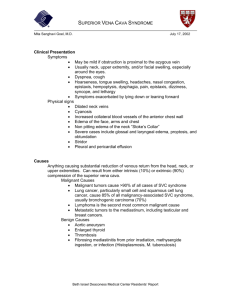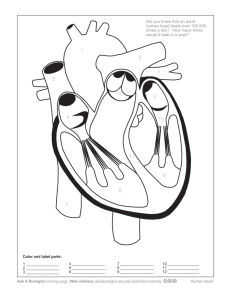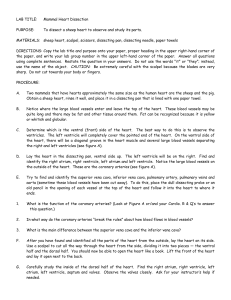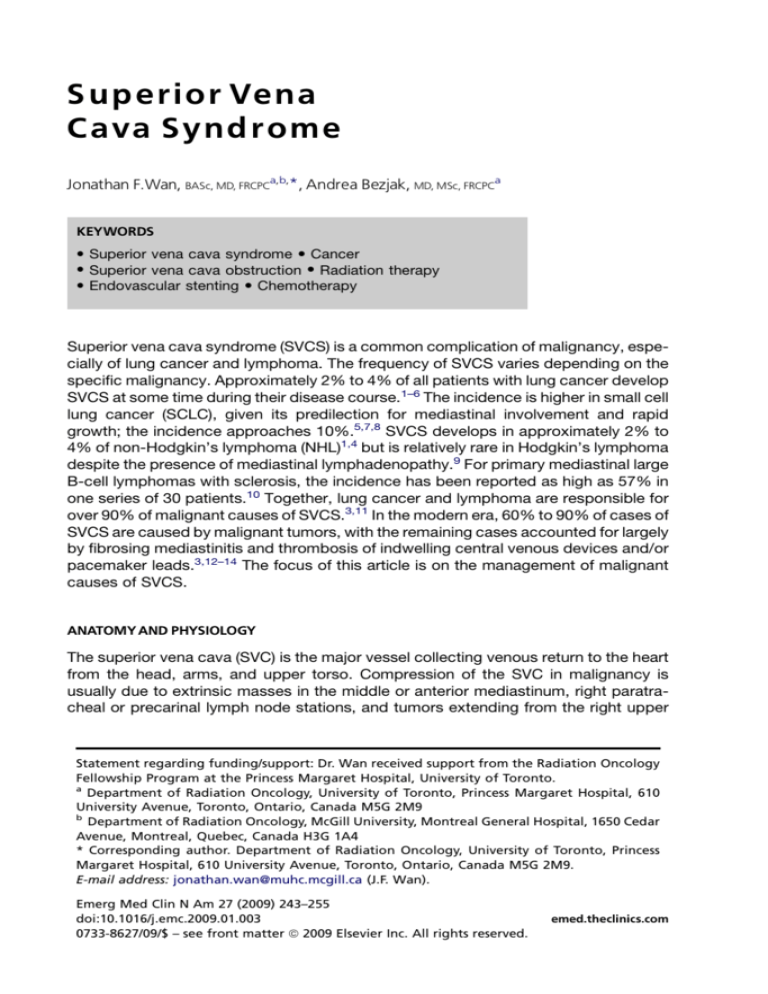
Superior Vena
Cava Syndrome
Jonathan F.Wan, BASc, MD, FRCPCa,b,*, Andrea Bezjak, MD, MSc, FRCPCa
KEYWORDS
Superior vena cava syndrome Cancer
Superior vena cava obstruction Radiation therapy
Endovascular stenting Chemotherapy
Superior vena cava syndrome (SVCS) is a common complication of malignancy, especially of lung cancer and lymphoma. The frequency of SVCS varies depending on the
specific malignancy. Approximately 2% to 4% of all patients with lung cancer develop
SVCS at some time during their disease course.1–6 The incidence is higher in small cell
lung cancer (SCLC), given its predilection for mediastinal involvement and rapid
growth; the incidence approaches 10%.5,7,8 SVCS develops in approximately 2% to
4% of non-Hodgkin’s lymphoma (NHL)1,4 but is relatively rare in Hodgkin’s lymphoma
despite the presence of mediastinal lymphadenopathy.9 For primary mediastinal large
B-cell lymphomas with sclerosis, the incidence has been reported as high as 57% in
one series of 30 patients.10 Together, lung cancer and lymphoma are responsible for
over 90% of malignant causes of SVCS.3,11 In the modern era, 60% to 90% of cases of
SVCS are caused by malignant tumors, with the remaining cases accounted for largely
by fibrosing mediastinitis and thrombosis of indwelling central venous devices and/or
pacemaker leads.3,12–14 The focus of this article is on the management of malignant
causes of SVCS.
ANATOMY AND PHYSIOLOGY
The superior vena cava (SVC) is the major vessel collecting venous return to the heart
from the head, arms, and upper torso. Compression of the SVC in malignancy is
usually due to extrinsic masses in the middle or anterior mediastinum, right paratracheal or precarinal lymph node stations, and tumors extending from the right upper
Statement regarding funding/support: Dr. Wan received support from the Radiation Oncology
Fellowship Program at the Princess Margaret Hospital, University of Toronto.
a
Department of Radiation Oncology, University of Toronto, Princess Margaret Hospital, 610
University Avenue, Toronto, Ontario, Canada M5G 2M9
b
Department of Radiation Oncology, McGill University, Montreal General Hospital, 1650 Cedar
Avenue, Montreal, Quebec, Canada H3G 1A4
* Corresponding author. Department of Radiation Oncology, University of Toronto, Princess
Margaret Hospital, 610 University Avenue, Toronto, Ontario, Canada M5G 2M9.
E-mail address: jonathan.wan@muhc.mcgill.ca (J.F. Wan).
Emerg Med Clin N Am 27 (2009) 243–255
doi:10.1016/j.emc.2009.01.003
0733-8627/09/$ – see front matter ª 2009 Elsevier Inc. All rights reserved.
emed.theclinics.com
244
Wan & Bezjak
lobe bronchus. As the tumors increase in size and produce compression of the SVC,
there is increased resistance to venous blood flow, which is then diverted through
collateral networks that may develop. Collateral vessels that are commonly found
include azygos, intercostal, mediastinal, paravertebral, hemiazygos, thoracoepigastric, internal mammary, thoracoacromioclavicular, and anterior chest wall veins.15
The severity of SVCS is worse if the level of obstruction is below the azygos vein,
underscoring the importance of this vessel in providing an alternate route for blood
flow.16 The severity of the obstruction is also dependent on the rapidity of onset of
the obstruction. Collateral vessels often take several weeks to dilate sufficiently to
accommodate the diverted blood flow of the SVC. The presence of collateral vessels
with compression of SVC on computed tomography (CT) is a reliable indicator of the
presence of SVCS with a sensitivity of 96% and specificity of 92%.17
PRESENTATION
Patients often complain of a variety of symptoms. The most common of these are
facial or neck swelling (82%), arm swelling (68%), dyspnea (66%), cough (50%),
and dilated chest veins (38%).11,13 Patients may also report chest pain, dysphagia,
hoarseness, headache, confusion, dizziness, and syncope. Orthopnea is commonly
noted, since a supine position will increase the amount of blood flow to the upper
torso. Attention should be given to the duration of symptoms, previous diagnosis of
malignancy, or previous intravascular procedures for clues to the etiology of the
syndrome. In most cases, symptoms develop over the course of several weeks allowing for collateral circulations to develop.
Worrisome signs include stridor, as this is usually indicative of laryngeal edema, as
well as confusion and obtundation, since these may indicate cerebral edema.
Although SVCS is now known not to be a major threat to life in most clinical scenarios,
evidence of respiratory and neurologic compromise can be associated with serious or
fatal outcomes. In addition, patients may have other cancer-related symptoms, such
as extrinsic compression of major airway by tumor (which may be an alternate explanation for the stridor), hemoptysis, or thrombosis associated with malignant SVCS,
which may need to be addressed urgently and may be more life threatening. Patients
may also have B symptoms (eg, drenching night sweats, weight loss, or fevers usually
associated with lymphomas) or other constitutional symptoms.
In the past, SVCS was considered to be a medical emergency. However, multiple
retrospective reviews have shown that this is not the case in the absence of laryngeal/bronchial or cerebral edema.13,14,18 Accurate diagnosis via imaging and biopsy
should be obtained, since treatment approaches can vary widely depending on the
histology of the malignancy. Staging investigations should be completed before initiating treatment if possible, because a decision will need to be made regarding a definitive curative approach as opposed to a palliative course of treatment.
Although no standardized grading system exists for the evaluation of SVCS, the
group from Yale University have recently proposed a classification system for grading
the severity of SVCS19 as asymptomatic (grade 0), mild (grade 1), moderate (grade 2),
severe (grade 3), life-threatening (grade 4), or fatal (grade 5). Cerebral edema, laryngeal edema, stridor, and hemodynamic compromise would constitute grade 3 (if
mild/moderate) or grade 4 (if significant) SVCS. The authors recommend more urgent
treatment be initiated in the presence of grade 3 or 4 symptoms. The proposed system
has not been validated but does provide a rational framework of how to approach and
triage these patients.
Superior Vena Cava Syndrome
The diagnosis of SVCS is made on the basis of clinical signs and symptoms and
confirmed by imaging studies.
EVALUATION
Physical examination should document the extent of facial, neck, and/or arm swelling,
elevation of neck veins, the extent of collateral veins on the chest, and any evidence of
respiratory compromise. Facial swelling and plethora are typically exacerbated when
patient is supine; the resultant cyanosis can be quite dramatic. Particular attention
should be given to any palpable nodes, as they may provide an easily accessible
site for tissue biopsy. Routine blood work should be obtained, including complete
blood counts, renal function, and liver enzymes. Abnormalities in blood work may indicate other possible sites of biopsy, such as bone marrow or liver lesions, and may
influence the subsequent therapy.
Imaging Studies
The majority of patients will have an abnormal chest radiograph (84%), with the most
common findings being mediastinal widening (64%) and pleural effusion (26%).12
Fig. 1 is an example of a chest radiograph from a patient with SVCS. The most useful
imaging study is computed tomography (CT) of the chest with contrast (needed to
evaluate the SVC).20,21 CT imaging allows the level and extent of the blockage to be
defined as well as an evaluation of collateral pathways of drainage. It also permits
identification of the cause of the obstruction, since a malignant mass is responsible
for up to 90% of SVCS. Common findings on CT include enlarged paratracheal lymph
nodes with or without additional lung or pleural abnormalities. A classic example of
SVCS is shown in Fig. 2, where contrast clearly delineates compression of the SVC
and the development of collateral vessels.
Venography is primarily used if an interventional stent is planned. Radionuclide
Tc-99 m venography fails to provide the diagnostic information that is supplied by
chest CT regarding location and characteristics of extrinsic masses. However, this
technique can be useful for identifying thrombotic obstructions within the SVC.22,23
Magnetic resonance imaging may be useful for patients who cannot tolerate CT
contrast for any reason to assess mediastinal veins.24,25
Fig. 1. Chest radiograph demonstrating mediastinal widening.
245
246
Wan & Bezjak
Fig. 2. Axial image of CT thorax, demonstrating a right paratracheal soft tissue mass causing
narrowing and compression of SVC and presence of collaterals.
In addition to imaging of the chest, a full diagnostic workup for the suspected cancer
may be appropriate either at this time or after the tissue diagnosis is obtained. For lung
cancer, this typically includes imaging of the abdomen, brain, and bone; for
lymphomas, this includes imaging of the abdomen and pelvis, possibly a bone marrow
biopsy and a gallium and/or fluorodeoxyglucose positron emission tomographic scan,
if appropriate.
Diagnostic Interventions
A tissue diagnosis is necessary to confirm the presence of a malignancy. In the
absence of acute airway compromise or progressive neurologic decline from cerebral
edema, initiation of therapy before obtaining a diagnosis is unwarranted given only
infrequent reports of mortality from SVCS in multiple series.13,14,18 However, the diagnostic workup should be expedited as patients may deteriorate quickly if collateral
vessels are not well established. The importance of a proper diagnosis and staging
of the patient cannot be overstressed. The treatment approaches vary widely depending on the type of malignancy present and whether an attempt will be made at definitive curative treatment as opposed to palliative approaches. Interventions such as
radiation, chemotherapy, and/or steroids may obscure a histologic diagnosis at a later
date. Radiation in particular can obscure a diagnosis in up to 42% of biopsy specimens obtained from the irradiated area after treatment.26
Careful clinical assessment of peripheral sites, such as supraclavicular nodes, that
are easily accessible must be made before proceeding to more invasive procedures,
such as bronchoscopy, mediastinoscopy, or endobronchial ultrasound guided biopsies (EBUS). Pleural effusions are also commonly found and are often accessible to
thoracocentesis, although the diagnostic yield may be suboptimal.27 Bronchoscopy
has a diagnostic yield of 50% to 70% (depending on the presence of a centrally
located lung mass), and transthoracic needle aspiration has a yield of 75%, whereas
mediastinoscopy has a diagnostic yield of 90% to 100% in determining the cause of
SVCS.28–32 The risks associated with mediastinoscopy, predominantly bleeding and
infection, are in the order of 0% to 7% in selected series.28,29,31,33,34 No specific
data exist with regard to the use of EBUS in obtaining a diagnosis in patients with
SVCS, although randomized data suggest that EBUS is superior to conventional transbronchial needle aspiration in obtaining a diagnosis should mediastinoscopy be
unavailable.8,35
Superior Vena Cava Syndrome
MANAGEMENT
Management of superior cava syndrome due to malignancy depends on the etiology
of the cancer, the extent of the disease, the severity of symptoms, and the prognosis
of the patient.19 Median life expectancy in patients with SVCS is approximately 6
months with a range of 1.5 to 9.5 months; however, estimates vary widely and are
dependent on the underlying malignant condition.36 Intervention needs to consider
both treatment of the cancer and relief of the symptoms of the obstruction. Treatment
of the cancer may be directed with curative intent or for palliation of symptoms alone.
The intent of treatment is not always immediately clear, and therapy may need to be
initiated before a full staging workup. For these reasons, the physician may wish to
allow for a flexible treatment approach that would allow for conversion from a palliative
approach to definitive management of the disease as the patient’s status improves.
Data from randomized trials are scarce, and most evidence guiding treatment decisions are from case series. The treatment options include supportive measures, RT,
chemotherapy, and stent insertion. Surgery is virtually never an option, as the presence of SVCS almost always signifies unresectable tumor within the mediastinum.
Although there may be a role for surgery after induction treatment for selected patients
with mediastinal nodal disease from lung cancer, it would be unlikely that a patient
who presented with SVCS would have potentially resectable nodal disease. However,
if in doubt, surgical input as part of multidisciplinary assessment may be sought,
although the most efficient approach would be to refer to a specialist who is most likely
to initiate appropriate therapy for the patient.
Interventions for Symptom Relief
Initial interventions should be directed toward supportive care and medical management. Although there are no data documenting the effectiveness of such maneuvers,
these measures can be performed with minimal risk and may provide initial relief of the
symptoms of SVCS. Oxygen support and attempts to minimize the hydrostatic pressure in the upper torso, such as fluid limitation, head elevation, and diuretics, may be
useful in reducing symptoms in the short term.
Recognition of life-threatening symptoms suggestive of airway compromise and/or
cerebral edema is essential. Evidence of severe airway compromise, such as stridor,
accompanied by findings of laryngeal edema or tracheal obstruction on CT should be
addressed emergently with interventions to protect the airway, such as an endotracheal tube. Management of cerebral edema associated with SVCS has not been
described in the literature. Standard resuscitation techniques should be considered,
such as head elevation, hyperventilation, and use of osmotic diuretics such as
mannitol, if the patient presents with symptoms suggestive of cerebral edema.
Imaging for an intracranial cause of cerebral edema should be obtained as well. In
both cases, the patient should be hospitalized, monitored closely, and treated urgently
to relieve the SVCS.
Steroids are often used as a temporary measure to reduce edema and associated
symptoms,37 but there is an absence of data documenting the effectiveness and dose
of steroids in this setting. There is also a risk of obscuring the tissue diagnosis, especially if lymphoma is suspected.3,5 In one retrospective review of 107 patients, the use
of steroids and diuretics or neither therapy had a similar rate of clinical improvement of
84%.13 However, in a symptomatic patient in whom airway edema is believed to
contribute to the symptoms, steroids can be an effective intervention. No standard
dosing or guidelines exist with regard to the dose of steroids to be used. At our
247
248
Wan & Bezjak
institution, dexamethasone 4 mg orally twice a day or 4 mg orally four times a day is
often initiated.
It should be emphasized that steroids should only be used as an initial temporizing
measure. Chronic use of high doses of steroids can result in significant side effects,
including facial swelling (cushingoid facies), and promote fluid retention, both of which
could aggravate the symptoms of SVCS.38,39 Prolonged use of high doses of corticosteroids can also complicate assessment of therapeutic effectiveness, as the side
effects of steroids can overlap with the symptoms of SVCS.
One should also be acutely aware that thrombosis may contribute to the severity of
the SVCS as well as pose a major threat to life should pulmonary embolus or further
thrombotic events occur. The incidence of thromboembolic events in patients with
malignant SVCS has been reported as high as 38% in a group of prospectively followed patients.40 There are less data guiding the decision to anticoagulate patients
with malignant SVCS (without documented thrombus), with only an older, small,
randomized trial that showed no difference in survival between patients anticoagulated versus those who were not.41 Unfortunately, this trial did not report the incidence
of pulmonary embolism. In summary, there is no evidence to support routine anticoagulation in patients with malignant SVCS in the absence of thrombosis. It appears
reasonable to anticoagulate patients with demonstrable thrombus on imaging.
After a tissue diagnosis has been obtained and the extent of the disease has been
determined, a decision should be made to address control of the malignant process in
either a curative fashion or palliatively. Radiation, chemotherapy, or stent placement,
or a combination of these modalities will play a role as the definitive intervention of
SVCS, depending on the sensitivity of the specific tumor.
Radiation
Radiotherapy (RT) is an effective modality in the treatment of SVCS due to malignancy.
A systemic review of the literature, conducted by Rowell and Gleeson,5 documented
that radiation was effective at providing overall relief in approximately three-quarters
of SVCS due to SCLC and in two-thirds of SVCS due to non-small cell lung cancer
(NSCLC).
The rapidity of response is in the range of 7 to 15 days but may be seen as early as
72 hours after initiation of therapy.6,42–45 Relative contraindications to RT include
previous treatment with radiation in the same region, certain connective tissue disorders such as scleroderma, and known radioresistant tumor types (eg, sarcoma).
Response rates in the literature are often clinical, and there can be a significant discordance with objective response rates as measured by imaging. In one report, evaluation with serial venography documented complete relief in 31% and partial relief in
23% for a total objective response rate of 54%, which is somewhat lower than clinically reported response rates.46
The radiation treatment plan can vary based on the histology of the tumor as well as
the intent of treatment. For example, a definitive course of radiation for SCLC can
involve 3 to 6 weeks of daily or twice-a-day treatments (eg, 40 Gy in 15 daily fractions,
50 Gy in 25 fractions, 60 Gy in 30 fractions, or 45 Gy at fraction sizes of 1.5 Gy twice
a day over 3 weeks). In NSCLC, definitive treatment takes 6 to 7 weeks to administer in
daily fractions of 2 Gy. Palliative treatments are typically administered over a course of
1 to 2 weeks with larger fraction sizes of 3 Gy to 5 Gy (eg, 20 Gy in 5 fractions, 30 Gy in
10 fractions), with the goal of achieving a more rapid response by using larger daily
doses. Abbreviated treatments of 2 6-Gy fractions (12 Gy/2 fractions) have been reported to be effective in older patients with poorer performance status.47
Superior Vena Cava Syndrome
Radiation treatment planning usually involves CT-based simulation for designing RT
fields. The fields should encompass the gross tumor volume and involved nodal
regions and attempt to shield involved normal organs in the proximity of the tumor,
particularly lung and esophagus, to minimize the risk of side effects. The size and
configuration of the fields may be altered during the treatment course, as patients
may improve symptomatically, and tumor may shrink to allow for a higher curative
dose to be delivered.
Careful assessment of the patient is needed during the radiation treatment to
monitor for side effects as well as progression of radioresistant tumors necessitating
alternative interventions, such as stent placement and/or a protective airway if symptoms worsen. Occasionally, worsening of symptoms can be due to development of
a thrombus, in which case vascular imaging and anticoagulation should be
considered.
Chemotherapy
Lymphomas, SCLCs, and germ cell tumors are widely regarded as chemotherapysensitive tumors, with high rates of response and quick onset of tumor shrinkage.
Thus, chemotherapy is often used as the initial treatment for SVCS from such tumors.
RT alone can be used and can provide prompt responses as well for these malignancies; but it usually yields poorer long-term results and is used only in patients who are
not candidates for chemotherapy.4,6 Chemotherapy can relieve the symptoms of
SVCS in up to 80% of patients with NHL and 77% with SCLS.4,5 The response rate
of relief from SVCS treated with chemotherapy is similar to that of RT and ranges
from 7 to 15 days.36 Fig. 3 demonstrates the response of a patient with a chemotherapy-sensitive tumor. After several cycles of chemotherapy, the patient recovered
patency of his SVC with good symptomatic relief and reduction in tumor burden.
The addition of RT to chemotherapy did not significantly affect the relief of SVCS or
relapse rates in 2 randomized trials of SCLC and NSCLC as well as in a systemic
review of the published data.5,8,48 Once the symptomatic benefit is obtained, the
patient may be a candidate for curative treatment, which in cases of limited-stage
SCLC or early stage NHL would include the addition of RT to systemic chemotherapy,
as this has been shown to decrease local recurrence rates and improve survival in
these clinical scenarios.
Endovascular Stenting
Endovascular stenting can provide rapid relief by restoring venous return in patients
with SVCS. Relief can be immediate, but in most series, it is reported within 24 to
Fig. 3. Radiographic response of patient with malignant SVCS from a chemotherapy-sensitive tumor.
249
250
Wan & Bezjak
72 hours following the procedure.5,49–51 Stent placement can be especially useful
when urgent intervention is indicated for patients without a tissue diagnosis or who
have previously been treated with RT or in those who have known chemotherapyand radiation-resistant tumors. In addition, endovascular stenting may be considered
as a first-line intervention in patients with SVCS.52–54 Stents provide relief from the
obstruction in an immediate and direct fashion, but they do not deal with the cancer
itself. Thus, in many cases, stent placement is followed by other treatments, such
as radiation and/or chemotherapy.
Stent placement is usually performed under local anesthesia in an angiography
suite, with introduction of a guide wire via either the subclavian or internal jugular
vein with or without balloon angioplasty followed by deployment of a stent.53,55,56 If
a clot is encountered, thrombolytics are often used, although their benefit in this
context remains unclear, and the morbidity of stent placement does appear higher
with the use of thrombolytics.32,36,57 Even in the absence of a visible thrombus,
some advocate use of prophylactic anticoagulation (eg, with low-molecular-weight
heparin) after stent placement, given the presence of a foreign body and the fact
that cancer patients (particularly lung cancer patients) are at an increased risk of
thrombosis. Whether this is clearly beneficial is not known. The use of steroids is
also not mentioned in most studies.36 Whether or not a particular type of stent is
advantageous remains unknown.58,59
There are no randomized, controlled trials comparing the efficacy of endovascular
stenting with radiation or chemotherapy. The most extensive data come from
a systemic review of the literature by Rowell and Gleeson in which 23 stent studies
were combined for a total of 159 patients with SVCS due to either SCLC or NSCLC.36
The results were not reported separately for the different histologies. About 95% of the
patients experienced complete or partial relief of their symptoms following stenting;
the relapse rate was reported as 11%. In comparison, relief rates in 487 patients
with SCLC treated with chemotherapy alone, chemoradiotherapy, or RT were 77%,
83%, and 78% respectively; however, in NSCLC, relief rates in 243 patients treated
with chemotherapy or RT were 59% and 63%, respectively.36 From this review, stenting appears to be the most effective and rapid treatment available to patients with
SVCS due to malignancy. However, there are far fewer patients treated with stents
in the literature, and patient selection may have played a role. Thus, comparison of
outcomes is limited due to the absence of randomized studies. Obtaining randomized
data for a direct comparison is difficult for a number of reasons: one treatment may be
more immediately available than the other (eg, there may not be stent expertise, or
radiation may not be immediately available), or there may be a clinical reason to favor
one over the other (eg, stent may be preferred in a previous irradiated chest area; radiation can be initiated quickly if there are also symptoms of airway compromise;
chemotherapy may be chosen if it is a chemosensitive tumor).60 Thus, although
randomized trials have been attempted, to date, they have not been successfully
completed.60 Whether endovascular stenting is truly superior in longer-term palliation
of the symptoms of SVCS remains unknown.
SUMMARY AND RECOMMENDATIONS
SVCS is a common complication of malignancies such as lung cancer or lymphoma.
The presentation is often clinically striking, especially if not recognized early enough. It
requires a workup and formulation of a management plan, although not necessarily an
emergency intervention. In most cases, the initial management of this syndrome
should be directed at supportive care, including such maneuvers as elevation of the
Table 1
Advantages and disadvantages of radiation therapy, stent insertion, and chemotherapy
Radiation
Stent
Chemotherapy
Disadvantages
Advantages
Disadvantages
Advantages
Disadvantages
Noninvasive
intervention
Symptom relief
in 7–15 d
Rapid relief of
symptoms usually
within 24–72 h
Invasive intervention
Noninvasive
intervention
Symptom relief
in 7–15 d
Treats underlying
malignancy
May compromise
a tissue diagnosis if
not yet obtained
Does not compromise
a tissue diagnosis
Bleeding
complications
Treats underlying
malignancy
May compromise
a tissue diagnosis if
not yet obtained
—
May initially worsen
symptoms due to
inflammation
Allows option for
further treatment
with chemotherapy,
radiation, or
combined-modality
therapy
Increased risk of
thrombosis due
to foreign object
Does not require
specialized
equipment
Patient may be too
sick to tolerate
chemotherapy
—
—
—
Does not treat
the underlying
malignancy
Ability to be
administered
in ICU
Hematologic and
other toxicity
The interventions are supported by level of evidence B; there is no level A evidence specific to the management of SVCS.
Abbreviation: ICU, intensive care unit.
Superior Vena Cava Syndrome
Advantages
251
252
Wan & Bezjak
head, oxygen support, diuretics, and possibly steroids, although none has been
proven to be of benefit. This should be followed by confirmation of the presence of
venous obstruction with imaging and interventions to establish the etiology. A histologic diagnosis confirming malignancy should be obtained before initiating therapy
in a patient with no previous diagnosis of cancer. Steroids are often used to decrease
swelling but may obscure a histologic diagnosis. In patients with life-threatening signs,
such as worsening laryngeal edema and stridorous symptoms, initial placement of an
intravascular stent can provide rapid relief without compromising future treatments or
diagnostic interventions. One should also be vigilant for the presence or development
of thrombosis in these patients. There are no data to support routine anticoagulation in
patients with malignant SVCS without evidence of thrombus.
Following a diagnosis of malignancy, a decision should be made as to whether the
intent of treatment will be curative or palliative. Treatment planning should be multidisciplinary and include medical and radiation oncologists at an early stage. Treatment
options include stent placement, radiation alone, chemotherapy alone, and
combined-modality therapy. No randomized studies have shown superiority of one
approach over the other, and the choice should be tailored to the particular clinical
scenario.
For patients with a newly diagnosed chemotherapy- sensitive malignancy, such as
SCLC, NHL, and germ cell tumors, systemic chemotherapy as an initial intervention is
reasonable. The use of stents in severely symptomatic patients can provide rapid relief
if necessary. Radiation alone is also an effective intervention in these malignancies
should chemotherapy be unavailable or contraindicated.
For patients with a newly diagnosed NSCLC, endovascular stent placement or RT is
recommended as a first intervention. RT may be used alone or as part of a combinedmodality approach with concurrent or sequential chemotherapy. A direct comparison
of RT and stent placement has not been made in a randomized, control setting, but it
appears from retrospective reports that stent placement is at least as effective as radiation with regard to relief rates and is certainly more rapid. A qualitative comparison of
the 3 interventions is presented in Table 1.
For patients who have recurrent or progressive malignancies and symptomatic SVC
who have had previous radiation in the mediastinum, we recommend consideration of
endovascular stents for relief of symptoms. Whether or not radiation can be delivered
to the same area again will depend on the dose and technique of previous radiation. If
previous RT was administered with palliative intent, ie, lower to moderate doses,
further RT may be possible, but would require careful planning to avoid organs at
risk of re-irradiation, particularly the spinal cord, if treated before. If previous RT
was high dose, it may not be possible to safely deliver further RT, and stent would
indeed be the best consideration.
For patients who are treated with radiation with severe airway obstruction, a short
course of steroids (dexamethasone 4 mg orally twice a day to 4 mg orally four times
a day) is reasonable during the radiation to prevent further compromise due to worsening swelling caused by acute radiation response, but there is no evidence supporting this intervention.
The treatment of SVCS secondary to malignancy must be individualized, based on
previous treatments as well as overall prognosis. The median survival in patients presenting with SVCS ranges from 1.5 to 9.5 months in the literature and must be kept in
mind when tailoring an approach for these patients.5 For patients with short life expectancy, the focus will be on short-term symptom relief. For patients with longer prognosis, more definitive treatment targeting not only the obstruction but the local
tumors would provide better chances of control of SVCS.
Superior Vena Cava Syndrome
REFERENCES
1. Armstrong BA, Perez CA, Simpson JR, et al. Role of irradiation in the management of
superior vena cava syndrome. Int J Radiat Oncol Biol Phys 1987;13(4):531–9.
2. Markman M. Diagnosis and management of superior vena cava syndrome. Cleve
Clin J Med 1999;66(1):59–61.
3. Ostler PJ, Clarke DP, Watkinson AF, et al. Superior vena cava obstruction:
a modern management strategy. Clin Oncol (R Coll Radiol) 1997;9(2):83–9.
4. Perez-Soler R, McLaughlin P, Velasquez WS, et al. Clinical features and results of
management of superior vena cava syndrome secondary to lymphoma. J Clin
Oncol 1984;2(4):260–6.
5. Rowell NP, Gleeson FV. Steroids, radiotherapy, chemotherapy and stents for
superior vena caval obstruction in carcinoma of the bronchus: a systematic
review. Clin Oncol (R Coll Radiol) 2002;14(5):338–51.
6. Sculier JP, Evans WK, Feld R, et al. Superior vena caval obstruction syndrome in
small cell lung cancer. Cancer 1986;57(4):847–51.
7. Chen YM, Yang S, Perng RP, et al. Superior vena cava syndrome revisited. Jpn J
Clin Oncol 1995;25(2):32–6.
8. Spiro SG, Shah S, Harper PG, et al. Treatment of obstruction of the superior vena
cava by combination chemotherapy with and without irradiation in small-cell
carcinoma of the bronchus. Thorax 1983;38(7):501–5.
9. Presswala RG, Hiranandani NL. Pleural effusion and superior vena cava canal
syndrome in Hodgkin’s disease. J Indian Med Assoc 1965;45(9):502–3.
10. Lazzarino M, Orlandi E, Paulli M, et al. Primary mediastinal B-cell lymphoma with
sclerosis: an aggressive tumor with distinctive clinical and pathologic features. J
Clin Oncol 1993;11(12):2306–13.
11. Rice TW, Rodriguez RM, Light RW. The superior vena cava syndrome: clinical
characteristics and evolving etiology. Medicine (Baltimore) 2006;85(1):37–42.
12. Parish JM, Marschke RF Jr, Dines DE, et al. Etiologic considerations in superior
vena cava syndrome. Mayo Clin Proc 1981;56(7):407–13.
13. Schraufnagel DE, Hill R, Leech JA, et al. Superior vena caval obstruction. Is it
a medical emergency? Am J Med 1981;70(6):1169–74.
14. Yellin A, Rosen A, Reichert N, et al. Superior vena cava syndrome. The myth–the
facts. Am Rev Respir Dis 1990;141(5 Pt 1):1114–8.
15. Eren S, Karaman A, Okur A. The superior vena cava syndrome caused by malignant
disease. Imaging with multi-detector row CT. Eur J Radiol 2006;59(1):93–103.
16. Stanford W, Jolles H, Ell S, et al. Superior vena cava obstruction: a venographic
classification. AJR Am J Roentgenol 1987;148(2):259–62.
17. Kim HJ, Kim HS, Chung SH. CT diagnosis of superior vena cava syndrome:
importance of collateral vessels. AJR Am J Roentgenol 1993;161(3):539–42.
18. Gauden SJ. Superior vena cava syndrome induced by bronchogenic carcinoma:
is this an oncological emergency? Australas Radiol 1993;37(4):363–6.
19. Yu JB, Wilson LD, Detterbeck FC. Superior vena cava syndrome–a proposed classification system and algorithm for management. J Thorac Oncol 2008;3(8):811–4.
20. Schwartz EE, Goodman LR, Haskin ME. Role of CT scanning in the superior vena
cava syndrome. Am J Clin Oncol 1986;9(1):71–8.
21. Bechtold RE, Wolfman NT, Karstaedt N, et al. Superior vena caval obstruction:
detection using CT. Radiology 1985;157(2):485–7.
22. Conte FA, Orzel JA. Superior vena cava syndrome and bilateral subclavian vein
thrombosis. CT and radionuclide venography correlation. Clin Nucl Med 1986;
11(10):698–700.
253
254
Wan & Bezjak
23. Podoloff DA, Kim EE. Evaluation of sensitivity and specificity of upper extremity
radionuclide venography in cancer patients with indwelling central venous catheters. Clin Nucl Med 1992;17(6):457–62.
24. Hansen ME, Spritzer CE, Sostman HD. Assessing the patency of mediastinal and
thoracic inlet veins: value of MR imaging. AJR Am J Roentgenol 1990;155(6):
1177–82.
25. Hartnell GG, Hughes LA, Finn JP, et al. Magnetic resonance angiography of the
central chest veins. A new gold standard? Chest 1995;107(4):1053–7.
26. Loeffler JS, Leopold KA, Recht A, et al. Emergency prebiopsy radiation for mediastinal masses: impact on subsequent pathologic diagnosis and outcome. J Clin
Oncol 1986;4(5):716–21.
27. Rice TW, Rodriquez RM, Barnette R, et al. Prevalence and characteristics of pleural
effusions in superior vena cava syndrome. Respirology 2006;11(3):299–305.
28. Mineo TC, Ambrogi V, Nofroni I, et al. Mediastinoscopy in superior vena cava obstruction: analysis of 80 consecutive patients. Ann Thorac Surg 1999;68(1):223–6.
29. Porte H, Metois D, Finzi L, et al. Superior vena cava syndrome of malignant origin.
Which surgical procedure for which diagnosis? Eur J Cardiothorac Surg 2000;
17(4):384–8.
30. Selcuk ZT, Firat P. The diagnostic yield of transbronchial needle aspiration in
superior vena cava syndrome. Lung Cancer 2003;42(2):183–8.
31. Trinkle JK, Bryant LR, Malette WG, et al. Mediastinoscopy–diagnostic value
compared to bronchoscopy: scalene biopsy and sputum cytology in 155
patients. Am Surg 1968;34(10):740–3.
32. Wilson LD, Detterbeck FC, Yahalom J. Clinical practice. Superior vena cava
syndrome with malignant causes. N Engl J Med 2007;356(18):1862–9.
33. Jahangiri M, Taggart DP, Goldstraw P. Role of mediastinoscopy in superior vena
cava obstruction. Cancer 1993;71(10):3006–8.
34. Callejas MA, Rami R, Catalan M, et al. Mediastinoscopy as an emergency diagnostic procedure in superior vena cava syndrome. Scand J Thorac Cardiovasc
Surg 1991;25(2):137–9.
35. Herth F, Becker HD, Ernst A. Conventional vs endobronchial ultrasound-guided
transbronchial needle aspiration: a randomized trial. Chest 2004;125(1):322–5.
36. Rowell NP, Gleeson FV. Steroids, radiotherapy, chemotherapy and stents for
superior vena caval obstruction in carcinoma of the bronchus. Cochrane Database Syst Rev 2001;(4):CD001316.
37. Kaplan AP, Greaves MW. Angioedema. J Am Acad Dermatol 2005;53(3):373–88
quiz 389–92.
38. McDougall R, Sibley J, Haga M, et al. Outcome in patients with rheumatoid
arthritis receiving prednisone compared to matched controls. J Rheumatol
1994;21(7):1207–13.
39. Wei L, MacDonald TM, Walker BR. Taking glucocorticoids by prescription is associated with subsequent cardiovascular disease. Ann Intern Med 2004;141(10):
764–70.
40. Adelstein DJ, Hines JD, Carter SG, et al. Thromboembolic events in patients with
malignant superior vena cava syndrome and the role of anticoagulation. Cancer
1988;62(10):2258–62.
41. Ghosh BC, Cliffton EE. Malignant tumors with superior vena cava obstruction. N Y
State J Med 1973;73(2):283–9.
42. Dombernowsky P, Hansen HH. Combination chemotherapy in the management of
superior vena caval obstruction in small-cell anaplastic carcinoma of the lung.
Acta Med Scand 1978;204(6):513–6.
Superior Vena Cava Syndrome
43. Kane RC, Cohen MH. Superior vena caval obstruction due to small-cell
anaplastic lung carcinoma. Response to chemotherapy. JAMA 1976;235(16):
1717–8.
44. Maddox AM, Valdivieso M, Lukeman J, et al. Superior vena cava obstruction in
small cell bronchogenic carcinoma. Clinical parameters and survival. Cancer
1983;52(11):2165–72.
45. Tan EH, Ang PT. Resolution of superior vena cava obstruction in small cell lung
cancer patients treated with chemotherapy. Ann Acad Med Singap 1995;24(6):
812–5.
46. Ahmann FR. A reassessment of the clinical implications of the superior vena caval
syndrome. J Clin Oncol 1984;2(8):961–9.
47. Lonardi F, Gioga G, Graziella A, et al. Double-flash, large-fraction radiation
therapy as palliative treatment of malignant superior vena cava syndrome in
the elderly. Support Care Cancer 2002;10(2):156–60.
48. Pereira JR, Martins CJ, Ikari FK, et al. Neoadjuvant chemotherapy vs. radiotherapy alone for superior vena cava syndrome (SVCS) due to non-small cell
lung cancer (NSCLC): preliminary results of a randomized phase II trial. Eur J
Cancer 1999;35(Suppl 4):260.
49. Hennequin LM, Fade O, Fays JG, et al. Superior vena cava stent placement:
results with the Wallstent endoprosthesis. Radiology 1995;196(2):353–61.
50. Irving JD, Dondelinger RF, Reidy JF, et al. Gianturco self-expanding stents: clinical experience in the vena cava and large veins. Cardiovasc Intervent Radiol
1992;15(5):328–33.
51. Rosch J, Uchida BT, Hall LD, et al. Gianturco-Rosch expandable Z-stents in the
treatment of superior vena cava syndrome. Cardiovasc Intervent Radiol 1992;
15(5):319–27.
52. Bierdrager E, Lampmann LE, Lohle PN, et al. Endovascular stenting in neoplastic
superior vena cava syndrome prior to chemotherapy or radiotherapy. Neth J Med
2005;63(1):20–3.
53. Greillier L, Barlesi F, Doddoli C, et al. Vascular stenting for palliation of superior
vena cava obstruction in non-small-cell lung cancer patients: a future ‘standard’
procedure? Respiration 2004;71(2):178–83.
54. Kim YI, Kim KS, Ko YC, et al. Endovascular stenting as a first choice for the palliation of superior vena cava syndrome. J Korean Med Sci 2004;19(4):519–22.
55. de Gregorio Ariza MA, Gamboa P, Gimeno MJ, et al. Percutaneous treatment of
superior vena cava syndrome using metallic stents. Eur Radiol 2003;13(4):
853–62.
56. Nagata T, Makutani S, Uchida H, et al. Follow-up results of 71 patients undergoing metallic stent placement for the treatment of a malignant obstruction of
the superior vena cava. Cardiovasc Intervent Radiol 2007;30(5):959–67.
57. Crowe MT, Davies CH, Gaines PA. Percutaneous management of superior vena
cava occlusions. Cardiovasc Intervent Radiol 1995;18(6):367–72.
58. Oudkerk M, Kuijpers TJ, Schmitz PI, et al. Self-expanding metal stents for palliative treatment of superior vena caval syndrome. Cardiovasc Intervent Radiol
1996;19(3):146–51.
59. Schindler N, Vogelzang RL. Superior vena cava syndrome. Experience with endovascular stents and surgical therapy. Surg Clin North Am 1999;79(3):683–94, xi.
60. Wilson P, Bezjak A, Asch M, et al. The difficulties of a randomized study in superior vena caval obstruction. J Thorac Oncol 2007;2(6):514–9.
255

